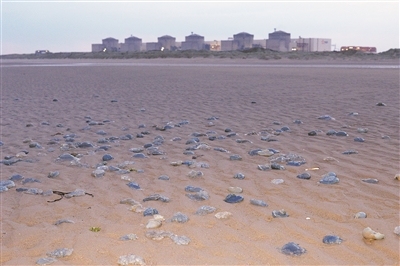
They are the "ballerinas" of the ocean, with lithe bodies and flowing tentacles, drifting like fallen leaves in the deep blue sea - when people think of jellyfish, their colorful figures often come to mind. Unexpectedly, France's largest nuclear power plant was "forced to shut down" by a tiny jellyfish. How did this delicate creature bring a large nuclear power plant to a halt?

Due to a large number of jellyfish entering the water intake system for cooling the reactors at the Gravelines nuclear power plant in France, the French Electricity Company was forced to shut down the plant. Image source: Visual China
Jellyfish swarms clog cooling filters
On August 11, local time, Electricité de France (EDF) said that four reactor units at the Gravelines nuclear power plant located in the northern coastal area of France were temporarily shut down due to the "appearance of a large number of unforeseen jellyfish" near the reactor cooling system.
The Gravelines nuclear power plant is France's largest, with six reactors and a total installed capacity of 5.4 gigawatts, accounting for approximately 6% of France's total electricity production. Reports indicate that between the late night of August 10th and the early morning of August 11th, four reactor units at the plant experienced shutdowns due to jellyfish blocking critical equipment. Two reactors were already undergoing summer maintenance, bringing all six units of the plant offline. Fortunately, the incident did not impact the plant, personnel, or the environment. As of August 13th, one reactor at the plant had been restarted and connected to the grid, and the remaining reactors are expected to resume operations within the next few days.
French media reported that such a large swarm of jellyfish had never been seen in the waters near the nuclear power plant before. These marine creatures, called giant barrel jellyfish, gathered in such large numbers that they blocked the filter drum at the reactor's seawater inlet, directly interfering with the normal operation of the reactor's cooling system.
Hervé Antajean, an expert at the French Research Institute for Exploitation of the Sea, told the media that the Gravelines nuclear power plant's cooling system draws water from the North Sea, which happens to be home to a variety of jellyfish. Antajean said these creatures are not able to swim well enough to change direction or avoid obstacles, and that their influx into Dunkirk Harbor is driven by ocean currents and winds. Fortunately, this situation is uncommon.
Jellyfish may become a frequent visitor to coastal power stations
After being "forced to shut down" by jellyfish, a spokesperson for the Gravelines nuclear power plant said that it is "quite rare" for a reactor to shut down due to a jellyfish invasion, but similar incidents have occurred many times in history, including in the United States, Canada, Sweden, Japan and other places.
In 2013, Sweden's largest nuclear reactor, Oskarshamn Nuclear Power Plant, was forced to shut down after a swarm of moon jellyfish swam into the cooling water intake. That same year, nuclear power plants in many countries, including Japan and Israel, were forced to shut down due to favorable weather conditions for jellyfish blooms.
According to documents from the U.S. Nuclear Regulatory Commission, U.S. nuclear power plants have also been shut down due to jellyfish infestations. In 2008, a large number of jellyfish blocked the circulating water filter at the Diablo Canyon 2 reactor in California, causing water pressure problems and requiring a shutdown. In 2011, a large number of jellyfish invaded the cooling water channels at the St. Lucie Nuclear Power Plant in Florida, clogging the pipes.
In 2023, China's Hongyanhe Nuclear Power Plant was shut down due to a large number of moon jellyfish entering the pump station forepool in the nearby waters.
It's not just nuclear power plants; coastal power plants face the same problem. Jellyfish are becoming a frequent visitor to coastal power plants. As jellyfish expert Lisa Ann Gershwin warns in her book "Sting!", jellyfish are taking over the oceans.
An article in the French newspaper L'Echo analyzed that the surge in jellyfish populations is closely related to human activities. On the one hand, overfishing has reduced the jellyfish's natural enemies and competitors; on the other hand, global warming has caused sea temperatures to rise, creating favorable conditions for the proliferation of plankton and the reproduction of jellyfish.
Studies have shown that rising sea temperatures can accelerate the development of jellyfish larvae. Excessive jellyfish reproduction makes them veritable "assassins" in the ocean. They not only compete with fish for food but also prey on the eggs and fry of other fish, depleting oxygen levels in the seawater. This detrimental effect on the survival of fish species already depleted by overfishing could trigger a vicious cycle in marine ecosystems. As ocean temperatures rise, the frequency and range of jellyfish outbreaks continue to increase.
It is imperative to prevent new risks
French experts who have been studying climate change for a long time believe that climate warming has a significant impact on the natural and ecological environment, which may bring new disasters to important infrastructure such as nuclear power plants. The French nuclear power plant was forced to shut down due to the surge in jellyfish. This risk is systemic and persistent.
The Paris-based Organization for Economic Cooperation and Development recently held a workshop on resilient infrastructure, focusing on the impacts of climate change on infrastructure. The workshop noted that extreme weather events are increasing in frequency and severity due to climate change, causing significant disruptions to infrastructure services such as water, sanitation, electricity, and transportation, with profound economic and social impacts. As the impacts of climate change escalate, there is an urgent need to build resilient infrastructure to withstand extreme weather events. At the same time, it is necessary to identify innovative solutions and technologies to enhance resilience, prioritizing nature-based solutions.
The jellyfish-induced shutdown of a French nuclear power plant serves as another wake-up call. The impacts of global climate change are profoundly impacting human society. Further research is needed into emerging risks arising from ecological changes to provide early warnings and mitigate losses. Critical infrastructure also needs to assess potential risks and mitigate them through natural or technological means to prevent them before they occur.
(Original title: "Why did a jellyfish invasion force the shutdown of France's largest nuclear power plant? Climate change causes failures of important infrastructure, worthy of vigilance.")
- gfGlbbWFBEEo08/19/2025
